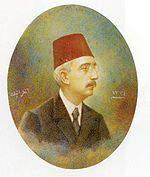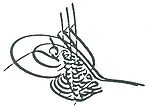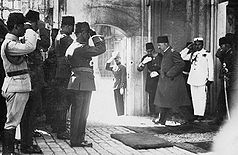- Mehmed VI
-
 Mehmed VI
Mehmed VISultan of the Ottoman Empire Caliph of Islam 
Reign 1918–1922 Period Dissolution of the Ottoman Empire Full Name Mehmed VI Born 14 January 1861 Birthplace Constantinople, modern day Istanbul Died 16 May 1926 (aged 65) Place of death Sanremo, Kingdom of Italy Buried Damascus Predecessor Mehmed V Successor Sultanate abolished
Abdülmecid IIWives Emine Nazikedâ Marjim-Abaza Kadın Efendi
Inshira Kadın Efendi
Sadiye Mevedett Kadın Efendi
Nevare Kadın Efendi
Nimit Nevzad Kadın EfendiOffspring Princess Münire Sultan
Princess Fatma Ulviye Sultan
Princess Rukiye Sabiha Sultan Hanım Efendi
Prince Şehzade Ertuğrul Mehmed EfendiRoyal House House of Osman Dynasty Ottoman Dynasty Mehmet VI (Ottoman Turkish: محمد سادس Meḥmed-i sâdis, واحد الدين Wahd aldyn. Turkish: Mehmed Vahideddin or Mehmet Vahdettin) (14 January 1861 – 16 May 1926) was the 36th and last Sultan of the Ottoman Empire, reigning from 1918 to 1922. The brother of Mehmed V, he succeeded to the throne as the eldest male member of the House of Osman after the 1916 suicide of Abdülaziz's son Yusuf Izzettin Efendi,[1] the heir to the throne. He was girded with the Sword of Osman on 4 July 1918, as the thirty-sixth padishah. His father was sultan Abdülmecid I and mother was Gülüstü (1831 – May 1861), a Circassian. Mehmed was removed from the throne when the Ottoman sultanate was abolished in 1922.
Contents
Royal title
Mehmet VI ruled as:
His Imperial Majesty, the Grand Sultan Mehmed VI Vahid ed-din, Emperor of the Ottomans, Commander of the Faithful and Successor of the Prophet of the Universe.[citation needed]Birth
He was born in the Dolmabahçe Palace or the Beşiktaş Palace, Beşiktaş, both in Constantinople.[2][3] On his ninth birthday he was ceremonially circumcised in the special Circumcision Room (Sünnet Odasi) of Topkapı Palace.
Reign
The First World War was a disaster for the Ottoman Empire. British and allied forces had conquered Baghdad, Damascus, and Jerusalem during the war and most of the Empire was divided among the European allies. At the San Remo conference of April 1920, the French were granted a mandate over Syria and the British were granted one over Palestine and Mesopotamia. On 10 August 1920, Mehmed's representatives signed the Treaty of Sèvres, which recognized the mandates, removed Ottoman control over Anatolia and İzmir, severely reduced the extent of Turkey, and recognized Hejaz as an independent state.
Turkish nationalists were angered by the Sultan's acceptance of the settlement. A new government, the Turkish Grand National Assembly, under the leadership of Mustafa Kemal (Atatürk) was formed on 23 April 1920, in Ankara (then known as Angora). The new government denounced the rule of Mehmed VI and a temporary constitution was drafted.
The Turkish Grand National Assembly abolished the Sultanate on 1 November 1922, and Mehmed left Constantinople, aboard the British warship Malaya on 17 November. He went into exile in Malta; Mehmed later lived on the Italian Riviera.
On 19 November 1922, Mehmed's first cousin and heir Abdülmecid Efendi was elected Caliph, becoming the new head of the Imperial House of Osman as Abdülmecid II before the Caliphate was abolished in 1924. Mehmed died on 16 May 1926 in Sanremo, Italy, and was buried at the mosque of Sultan Selim I in Damascus.[4]
Marriages and issue
First marriage and issue
His first marriage was to Abkhaz HH Emine Nazikedâ Marjim-Abaza Kadın Efendi (Sukhumi, Abkhazia, 9 October 1866 - Maadi, Cairo, 1944 and buried there) in the Ortaköy Palace, Constantinople, on 8 June 1885. Their issue was:
- HIH Princess Münire Sultan (1888 - 1888).
- HIH Princess Fatma Ulviye Sultan (Ortaköy Palace, Ortaköy, Constantinople, 11 September 1892 - İzmir, 25 January 1967 and buried at Çengelköy, Üsküdar, Istanbul, first married to HE Damat Ismail Hakki Okday Beyefendi (Athens, 28 October 1881 - Istanbul, 11 October 1977) at the Kurucheshme Palace, Constantinople, on 10 August 1916, without issue; second marriage to HE Damat Ali Haidar Beyefendi (Göztepe, Constantinople, 20 September 1889 - Istanbul, 5 February 1962) at the Nişantaşı Palace, Nişantaşı, Pera (today Beyoğlu), on 1 November 1923, also without issue.
- HH HIH Princess Rukiye Sabiha Sultan Hanım Efendi (the Ortaköy Palace, Ortaköy, Constantinople, 19 March/1 April 1894 - Istanbul, 26 August 1971), married to her cousin HIH Prince Şehzade Ömer Faruk Efendi (the Ortaköy Palace, Constantinople, 27/29 February 1898 - 28 March 1969/1971), son of Abdülmecid II, at the Yıldız Palace, Constantinople, on 29 April 1920 as his first wife. Their issue was:
- HIH Princess Fatma Neslişah Osmanoğlu Sultan (Constantinople, Nişantaşı, Nişantaşı Palace, 4 February 1921 -), married in Heliopolis Palace, Cairo, on 26 September 1940 to her cousin HE Damat HH Prince/HRH Prince Muhammad Abdel Moneim Beyefendi (Alexandria, Montaza Palace, 20 February 1899 - Constantinople, 1/2 December 1979, buried in Cairo), Heir Apparent to the Throne of Egypt from 1899 to 1914, created HH in 1922, created HRH in 1952, Regent of Egypt from 1952 to 1953, and had issue.
Second marriage
His second marriage was to Georgian HH Seniye Inshira Kadın Efendi (Batumi, 10 July 1887 - Cairo, 10 June 1930) at the Çengelköy Palace, Çengelköy, Üsküdar, Constantinople, on 8 July 1905. The marriage ended in divorce because of an affair with Prens Sabahaddin,she bore him a son in 1910 in Exile on Heybeliada, one of the Princes' Islands of Istanbul, in the days of the Ottoman Empire.
Third marriage and issue
His third marriage was to HH Sadiye Mevedett Kadın Efendi (Adapazarı, 12 October 1893 - Çengelköy Palace, Çengelköy, Üsküdar, Constantinople, 1951 and buried there), at the Çengelköy Palace, Çengelköy, Üsküdar, Constantinople, on 25 April 1911, Their only issue was:
- HIH Prince Şehzade Ertuğrul Mehmed Efendi (Çengelköy Palace, Çengelköy, Üsküdar, Constantinople, 5 September 1912 - Cairo, 2 July 1944).Issue unsure.
Fourth marriage
His fourth marriage was to HH Nevare Kadın Efendi (Adapazarı, 4 May 1901 - ?) at the Dolmabahçe Palace, Constantinople, on 20 June 1918. They divorced in 1924, without issue.
Fifth marriage
His fifth marriage was to HH Nimit Nevzad Kadın Efendi ([Constantinople], 2 March 1902 - bef. 1985/199?) at the Yıldız Palace, [Constantinople], on 1 September 1921 and was without issue
Notes
- ^ Freely, John, Inside the Seraglio, 1999, Chapter 16: The Year of Three Sultans.
- ^ Chisholm, Hugh, ed. (1911), The Encyclopædia Britannica, 7, "Constantinopole, the capital of the Turkish Empire…".
- ^ Britannica, Istanbul:When the Republic of Turkey was founded in 1923, the capital was moved to Ankara, and Constantinople was officially renamed Istanbul in 1930.
- ^ Freely, John, Inside the Seraglio, published 1999, Chapter 19: The Gathering Place of the Jinns
Further reading
- Fromkin, David, 1989. A Peace to End All Peace: The Fall of the Ottoman Empire and the Creation of the Modern Middle East ISBN 0-8050-0857-8
External links
Mehmed VIBorn: 14 January 1861 Died: 16 May 1926Regnal titles Preceded by
Mehmed VSultan of the Ottoman Empire
3 July 1918 – 1 November 1922Monarchy abolished
Sunni Islam titles Preceded by
Mehmed VCaliph of Islam
3 July 1918 – 19 November 1922Succeeded by
Abdülmecid IITitles in pretence Preceded by
Loss of actual title— TITULAR —
Sultan of the Ottoman Empire
1 November 1922 – 19 November 1922Abdülmecid II Ottoman Sultans / Caliphs Osman I · Orhan · Murad I · Bayezid I · Interregnum · Mehmed I · Murad II · Mehmed II · Murad II · Mehmed II · Bayezid II · Selim I · Suleiman I · Selim II · Murad III · Mehmed III · Ahmed I · Mustafa I · Osman II · Mustafa I · Murad IV · Ibrahim · Mehmed IV · Suleiman II · Ahmed II · Mustafa II · Ahmed III · Mahmud I · Osman III · Mustafa III · Abdülhamid I · Selim III · Mustafa IV · Mahmud II · Abdülmecid I · Abdülaziz · Murad V · Abdülhamid II · Mehmed V · Mehmed VI · Abdülmecid II (Caliph)Related Templates: Claimants · Valide SultansClaimants to the Ottoman throne since 1922 1922Mehmed VI1922–19441944–19541954–19731973–19771977–19831983–19941994–20092009–presentCurrent heir See also Ottoman DynastyCategories:
See also Ottoman DynastyCategories:- 1861 births
- 1926 deaths
- 20th-century Ottoman sultans
- 19th-century Ottoman people
- Ottoman people of Armenian descent
- Ottoman people of Albanian descent
- Ottoman people of Bulgarian descent
- Ottoman people of Circassian descent
- Ottoman people of Greek descent
- Dolmabahçe Palace
Wikimedia Foundation. 2010.


